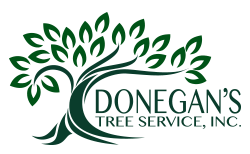The (Mostly) Harmless Fall Webworms
By Aprille Hunter
As you’ve been driving down the road the past few weeks, have you noticed thick webs hanging from the ends of tree limbs? If you haven’t yet, now you will! These webs are formed by webworms, native insects that eat from more than 100 different hardwood trees including maple, walnut, willow, and elm. The larvae are caterpillars that come in two color variations, and the adults are white moths with black spots.
In our climate zone, they have a season-specific life cycle, with nocturnal adult moths emerging from May to early July to begin laying eggs. When the eggs hatch two weeks later, the resulting larvae weave large silk tents on branches and within those tents they eat around the veins of leaves for 4 to 8 weeks until August/September, when they are ready to find a new location to undergo metamorphosis. Then they form a cocoon anywhere — in the soil, in a pile of leaves, on the side of a house or on a tree, where they overwinter until next summer.
Will they damage my tree?
The defoliation from their feeding can weaken the tree’s natural defense system if more than 20% of the foliage is eaten, but since the damage doesn’t occur until the fall, when deciduous trees are normally preparing to lose their foliage, the damage usually isn’t lethal. The most vulnerable trees are smaller, newly planted trees and those that have already been stressed from other factors. More than being harmful, the appearance of these thick silk tents is less than appealing to most homeowners.
What can I do about them?
Since it is a native insect, the fall webworm has many natural predators that will help to keep the population from getting out of hand – even though you may see particularly “bad” years for the webs on trees, it should balance out in a couple years’ time. If their removal is imperative to your landscape, the simplest way to be rid of the silk tents is to remove them with a stick, and place it in a bowl of soapy water.
Further information:
https://www.fs.usda.gov/Internet/FSE_DOCUMENTS/stelprdb5341330.pdf
https://www.pubs.ext.vt.edu/content/dam/pubs_ext_vt_edu/2808/2808-1013/ENTO-357.pdf

